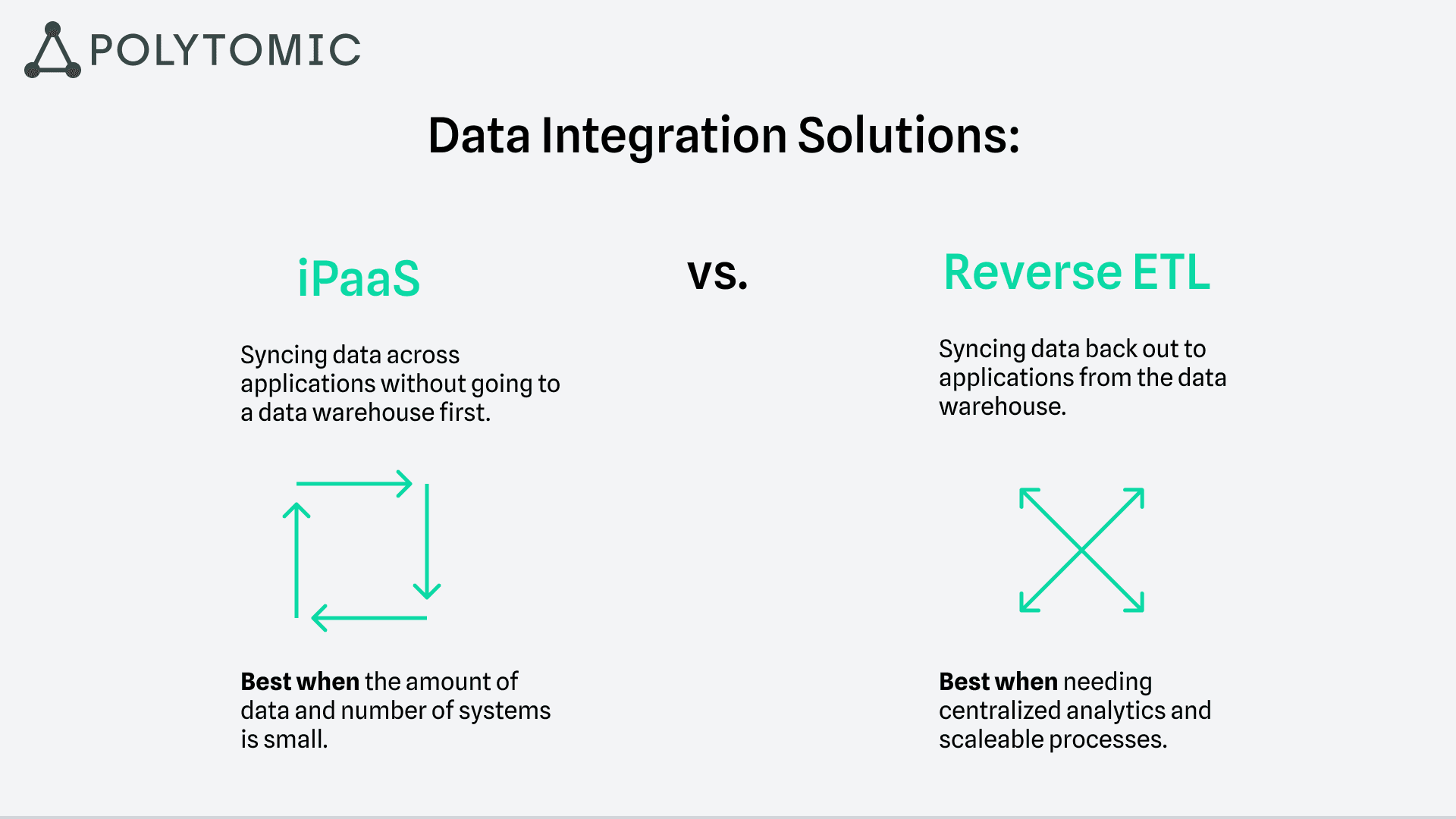iPaaS vs. Reverse ETL: Data Integration Solutions Explained
If data integration has been on your mind, you’re in the right place. Data integration can enable some wondrous use cases for your company when done right, and two methodologies have emerged to make it happen: Integration Platform as a Service (iPaaS) and Reverse Extract, Transform, Load (Reverse ETL).
Both have their strengths and weaknesses, and understanding these can help you make an informed decision about which is right for your organization's unique needs.
Overview of iPaaS and Reverse ETL

iPaaS is a cloud-based platform that connects various applications, data sources, and APIs in the cloud and on-premise. It's often used to automate workflows and eliminate the need for repetitive data entry. iPaaS solutions are typically easy to use and have a low entry barrier, making them a popular choice for early-stage businesses needing a few basic platform connections. However, as businesses grow and the number of integrations increases, iPaaS can become challenging to manage at scale.
Reverse ETL, on the other hand, is a relatively new concept in the data integration landscape. It flips the traditional ETL process on its head. Instead of extracting data from various sources, transforming it, and loading it into a data warehouse, Reverse ETL starts with data already in the warehouse. It then transforms and loads this data into various downstream applications (e.g., your CRM). This approach maintains a single source of truth – the data warehouse – and promotes better scalability, security, and maintenance.
Similarities Between iPaaS and Reverse ETL
Both iPaaS and Reverse ETL are designed to facilitate data integration, aiming to streamline the process of moving data between different systems. By having critical data synced across the applications that operational teams use (such as marketing, sales, CS, and finance), better business decisions can be made without having to hop across applications or wait on data teams to extract and analyze data for them.
Also, they both offer automation capabilities, reducing the need for manual data entry and minimizing the risk of human error.
Differences Between iPaaS and Reverse ETL
Despite their similarities, iPaaS and Reverse ETL have some key differences. iPaaS operates on a point-to-point model, moving data from one application to another. This approach can work well for simple, one-off scenarios, but it can lead to issues as the number of workflows and applications increases. iPaaS can also struggle with large-scale batch data updates, which can become expensive due to the pricing structure of most iPaaS tools (not with Polytomic though!).
Reverse ETL, however, operates on a hub-and-spoke model, with the data warehouse serving as the central hub. This model allows every application to access the whole, reliable, up-to-date truth, leading to more consistent customer experiences and more informed decision-making. Reverse ETL also excels at large-scale batch data updates, checking the table’s current state against the last sync and only sending the fields that have changed, saving time and money.
Choosing the Right Data Integration Method
When deciding between iPaaS and Reverse ETL, consider your company's size, the complexity of your data, and your specific use cases. If you're a small company with simple data integration needs, iPaaS might be sufficient. However, as your company grows and your data becomes more complex, Reverse ETL might be a better fit.
Consider the visibility and control you need over your data. iPaaS can lead to a lack of visibility as your company scales, with more people creating more dependencies without a clear view of how their workflows connect. On the other hand, Reverse ETL promotes a single source of truth, offering better visibility and control over your data.
Ultimately, the right tool for the job depends on your unique needs and circumstances. Polytomic is a unique solution in the market since we offer iPaaS and Reverse ETL capabilities all on the same no-code platform. In addition, our fixed pricing makes it so you never have to worry about getting hit with a big bill at the end of the month.
If that sounds interesting to you, start by getting a demo of our product.
